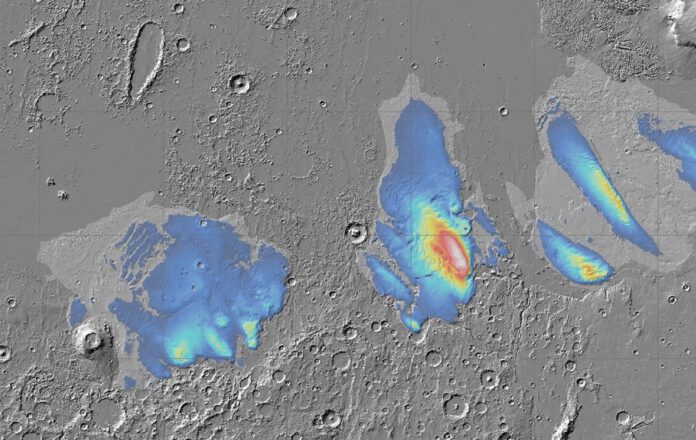
Over fifteen years ago, researchers discovered vast, underground deposits of an unknown nature near Mars’ equator. Could it be dust, volcanic ash, or perhaps sediments? Speculations persisted. Until now.
Observations by Mars Express, a Mars orbiter, suggest that this mysterious layer under the Martian surface is not built up from dust, ash, or sediments, but from water ice! If correct, this would involve a massive amount of ice: enough to, if melted, cover the entire planet of Mars with a water layer 1.5 to 2.7 meters thick!
Prior Research
These massive ice deposits are thought to be entrenched beneath the Martian surface near the equator. Looking back, researchers first stumbled upon these over fifteen years ago when they discovered extensive underground deposits in the same region, using Mars Express. However, clarity was lacking on the precise composition of these deposits.
Previous observations from Mars Express revealed that the deposits in the Medusae Fossae Formation had a limited density, tentatively suggesting it could be ice. Researchers could not wholly discount the possibility that the deposits were made up of dust, volcanic ash, or sediments though. This uncertainty led scientists to revisit it years later, ultimately leading to some remarkable findings. These deposits were found to be much thicker than previously thought. “Up to 3.7 kilometers,” says researcher Thomas Watters. More intriguingly, “Excitingly enough, the radar signals match what we would expect to see if it were layered ice. The radar signals are also comparable to the signals we see when looking at the Martian poles, which we know are ice-rich.”
Anomaly Resolved
Researchers now believe they can rule out the potentiality of the deposits being composed of dust, ash, or sediments, largely because the deposits are much deeper than previously thought. “If it was simply a massive pile of dust, we would expect it to be compressed under its own weight,” says researcher Andrea Cicchetti. “This would create something with a much greater density than what we actually see. And when we model how different ice-free materials would behave in such a situation, there is actually no material that can reproduce the properties we actually see – we need ice.”
Implications
Based on these new radar data, researchers are fairly convinced that, even near the equator of Mars, enormous amounts of water ice are hidden. This is interesting for several reasons. For one, this store of water ice could not have formed in the current – dry – Martian climate. This suggests that it hails from a different era. This raises numerous questions, observes researcher Colin Wilson. “When were these ice deposits formed and what did Mars look like then? If it can be confirmed that it is water ice, these vast deposits could change our understanding of Mars’ climatic history. Any reservoir filled with ‘old’ water is moreover a fascinating target for further exploration by humans or robots.”
Manned Missions
The massive amount of water could also be interesting for our future plans to visit Mars. Future manned missions to the Red Planet will likely head for the equator; far from the ice-rich poles and glaciers lying at higher latitudes. However, for those manned missions, having water near the landing site would be highly advantageous. Therefore, the tentative discovery of the so far largest water deposit near the equator is encouraging news. “Unfortunately, these deposits are covered by hundreds of meters of dust, making them inaccessible for at least the next few decades,” notes Wilson. “But any bit of ice we find helps us to get a better picture of where water has flowed on Mars in the past and where it can be found today.”
Future Exploration
Attention is also being directed to another Mars orbiter, the Trace Gas Orbiter (TGO), as it specifically hunts for water ice up to a meter deep. The orbiter had previously discovered a hydrogen-rich area the size of the Netherlands along the equator in the Valles Marineris canyon system. Currently, the orbiter seeks to map all surface-located water supplies on the Red Planet. “Together, our Mars explorers (TGO and Mars Express) are revealing more and more about our planetary neighbor,” concludes Colin.











